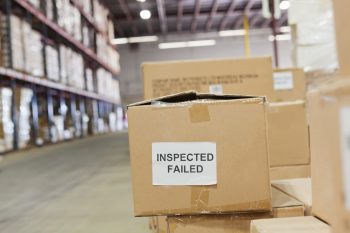Contributing writer for Wake Up World
The Toxic Substances Control Act (TSCA) requires that the U.S. Environmental Protection Agency compile and keep a current list of chemical substances manufactured or processed in the U.S. That list1 currently includes about 85,000 chemicals.
Among them are 10,000 chemicals allowed to be added to food and food-contact materials in the U.S., either directly or indirectly, yet few have been properly tested for safety.
An evaluation of nearly 4,000 additives intentionally added to food revealed 80 percent lacked enough information to determine how much could be safely eaten and only 6.7 percent had reproductive toxicology data.2 And that’s just food chemicals.
In recent years, researchers and scientists have raised warnings about mounting toxic exposures, leading to efforts to rein in the use of chemicals known to be hazardous to human health. Unfortunately, many companies are still failing in this regard.
Report Card Reveals Most Toxic Retailers
Three years ago, the Safer Chemicals, Healthy Families’ Mind the Store campaign started publishing a report card on retailer actions to eliminate toxic chemicals. The third annual report3,4 reveals which retailers have made strides to protect its customers from toxic chemicals in the products they sell, and which ones have not. This year, chain restaurants were also included for the first time.
About half of the 40 companies evaluated have made “slow but meaningful progress at improving the chemical safety of the products, food and packaging they sell,” while the other half, including all restaurant chains, have not made any discernible efforts to reduce toxicity. According to the report, published November 14, 2018:5
“Four retailers received the highest grades for their work to protect customers from toxic products and packaging, setting the pace for the industry: Apple (A+), Target (A), Walmart (A-) and IKEA (A-).
In 2018, Walgreens, Rite Aid and Amazon were ranked ‘most improved’ with all three companies announcing sweeping chemical safety policies over the past two months.”
Mike Schade, campaign director for Safer Chemicals, Healthy Families commented on the results:6
“Companies can prevent harm and protect public health by taking commonsense steps to phase out toxic chemicals in everyday products. Retailers have an important role to play — they have both the power and the moral responsibility to eliminate and safely replace toxic chemicals to ‘mind the store.’ They should stop letting chemical corporations put public health at risk.”
Which Retailers Scored Failing Grades in 2018?
In all, 19 of the 40 retailers, grocery and fast food restaurant chains included in the review received an “F” in 2018 for “failing to announce policies or publicly report progress to assess, reduce or eliminate toxic chemicals in the products or packaging they sell.” As noted by Tracy Gregoire, project coordinator for Learning Disabilities Association of America’s Healthy Children:7
“Learning and developmental disabilities now affect 1 in 6 children. Over a quarter of these disabilities are linked to toxic chemical exposures. Prenatal and early childhood exposure to harmful chemicals in consumer products and food packaging can lead to lifelong impacts and chronic health conditions.
Major retailers have both the opportunity and the responsibility to become industry leaders by keeping toxic chemicals out of products and packaging to protect children’s minds and bodies.”
While some of the companies that received an “F” would seem like “givens,” even companies like Trader Joe’s and Publix are on this list.
|
Companies that received a Failing Grade for 20188 |
|
| Macy’s | Ulta Beauty |
| Ahold Delhaize | Nordstrom |
| Trader Joe’s | Panera Bread |
| Office Depot | Sally Beauty |
| McDonald’s | Starbucks |
| Subway | Restaurant Brands International |
| Dollar General | TJX Companies |
| Yum! Brands | Ace Hardware |
| Sobeys | 99 Cents Only |
| Publix | |
Executive director of the Environmental Health Strategy Center, Mike Belliveau, a coauthor of the report, said:9
“The food we buy should nourish us, not expose us to toxic chemicals from packaging and processing. Restaurant chains are serving up a recipe for poor health by failing to slash the use of toxic chemicals in food packaging and other food contact materials.
Toxic industrial chemicals like phthalates and PFAS don’t belong in the food we eat. Consumers expect a lot more leadership from food retailers in getting toxic chemicals out of the food supply chain.”
Key Findings
According to the report, this year’s analysis reveals five key findings:10
1. Retailers are making an effort to remove certain toxic chemicals from their products — Examples given include phthalates, parabens and formaldehyde in beauty and personal care products, and oxybenzone in sunscreens.
Rite Aid is planning to eliminate two types of phthalates from its private label products by 2020, and will phase out nine others. By the end of 2022, Home Depot will also prohibit two phthalates and seven other chemicals in any household cleaning products they sell.
Ten retailers — Lowe’s, Sherwin-Williams, The Home Depot, Walmart, True Value, PPG Paints, AutoZone, Kelly-Moore Paints, Canadian Tire and Home Hardware — have all vowed to cease selling paint strippers containing methylene chloride and NMP by the end of 2018.
According to the report, “At least three paint stripper brands have recently announced new products coming to market that are free of methylene chloride and NMP, showing the power of retailers to drive the development of safer solutions.”
2. Retailers are strengthening or adopting new policies to address toxic chemicals — Aside from Walgreens, Rite Aid and Amazon — which reported the most significant improvements in this regard — Target, Lowe’s, Costco, Kohl’s and Sephora also improved.
3. Retailers are “aligning around a common list of chemicals of concern” — primarily the beauty and personal care stewardship list,11 created by the Forum for the Future in collaboration with The Sustainability Consortium, which is a subset of a larger list12 containing several thousand chemicals with suspected toxicity, developed by government agencies in the U.S., Europe and other regions.
4. Food retailers, on the other hand, “seriously lag behind,” having been slow to adopt policies to reduce or eliminate known toxins such as phthalates and PFAS from their packaging and materials that come into contact with the food.
5. Despite progress, “too many” retailers are still not addressing the chemical safety of their products — “Almost half the retailers evaluated lacked even the most basic public chemicals policy,” the report states.
American Academy of Pediatrics Calls for Reduced Exposure to Chemicals
The fact that all food retailers received a failing score is disturbing, considering their overall impact on an individual’s day-to-day chemical exposure. As noted by Dr. Leonardo Trasande, a member of the American Academy of Pediatrics (AAP) Council on Environmental Health and lead author of the AAP’s policy statement on toxic food chemicals issued earlier this year:13
“There are critical weaknesses in the current food additives regulatory process, which doesn’t do enough to ensure all chemicals added to foods are safe enough to be part of a family’s diet. As pediatricians, we’re especially concerned about significant gaps in data about the health effects of many of these chemicals on infants and children …
Chemicals that affect the endocrine system, for example, can have lasting effects on a child since hormones coordinate complex functions throughout the body. Even small disruptions at key moments during development can have lifelong consequences.”
In July 2018, the AAP, a group of over 65,000 pediatricians in the U.S., issued a policy statement urging parents to limit their children’s exposure to plastic chemicals known to leach into food from packaging, as well as chemical food additives, warning the chemicals may damage their children’s health for years to come.14 In a policy statement, the AAP expressed concerns related to:15
“[T]he use of colorings, flavorings and chemicals deliberately added to food during processing (direct food additives) as well as substances in food contact materials, including adhesives, guys, coatings, paper, paperboard, plastic and other polymers which may contaminate food as part of packaging or manufacturing equipment …”
Some of those chemicals include phthalates, nitrates and bisphenols. Experts fear these chemicals have a range of side effects in humans, including metabolic dysfunction, thyroid and other endocrine disruption, impaired brain development, increasing risk of obesity and decreased birth weight.16 Synthetic hormones may also disrupt how calories are processed and ultimately how they are converted, contributing to metabolic dysfunction.
World Health Organization Has Also Issued Warnings About Food and Plastic Chemicals
A 2013 joint report by the World Health Organization (WHO) and the United Nations Environment Program17 also warned that an all-out ban on endocrine disrupting chemicals may be needed to protect the health of future generations.
This report is one of the most comprehensive on endocrine disrupting chemicals commonly found in plastics and food additives to date, and highlights a wide variety of problems, including undescended testicles, breast, prostate and thyroid cancer, nervous system defects and the development of attention deficit disorder and attention deficit hyperactivity disorder in children.18
Take Action
Toxic chemicals hide in most products you buy and use on an everyday basis. As noted by Mind the Store, “It’s time retailers put the interests of our families’ health above the special interests of chemical corporations. Big retailers can innovate to reduce or eliminate toxic chemicals from the products they carry and safeguard our health.”
If you agree, take action by contacting the CEOs of all 19 retailers with a failing score. Mind the Store makes it easy through their Action Network page.
Take Steps to Reduce Your Family’s Chemical Exposure
Considering all the potential sources of toxic chemicals, it’s virtually impossible to avoid all of them, but that doesn’t mean you have to sit silently by while corporations use your home, your water, your air, your food and your body as a convenient chemical dumping ground. Until change occurs on a global scale, you can significantly limit your exposure by keeping a number of key principles in mind.
|
Eat a diet focused on locally grown, fresh and ideally organic whole foods. Processed and packaged foods are a common source of chemicals, both in the food itself and the packaging. Wash fresh produce well, especially if it’s not organically grown. |
| Rather than eating conventional or farm-raised fish, which are often heavily contaminated with PCBs and mercury, supplement with a high-quality krill oil, or eat wild-caught Alaskan salmon, anchovies and sardines. |
| Choose certified organic grass fed meats and dairy to reduce your exposure to hormones, pesticides and fertilizers. Avoid milk and other dairy products containing genetically engineered recombinant bovine growth hormone (rBGH or rBST). |
| Store your food and beverages in glass, rather than plastic, and avoid using plastic wrap. |
| Buy products in glass bottles rather than plastic or cans, as chemicals can leach out of plastics (and plastic can linings), into the contents; be aware that even “BPA-free” plastics typically leach endocrine-disrupting chemicals that are just as bad. |
| Use glass baby bottles. |
| Replace your nonstick pots and pans with ceramic or glass cookware. |
| Look for Earth-friendly, animal-friendly, sustainable, certified organic and GMO-free products. This applies to everything from food and personal care products to building materials, carpeting, paint, baby items, furniture, mattresses and more. |
| Filter your tap water for both drinking and bathing. If you can only afford to do one, filtering your bathing water may be more important, as your skin readily absorbs contaminants. If your tap water is fluoridated, keep in mind that not all filter systems will filter out this toxic additive. |
| When buying new products such as furniture, mattresses or carpet padding, consider buying chemical-free varieties containing naturally less flammable materials, such as leather, wool, cotton, silk and Kevlar, to avoid exposure to toxic flame retardants. |
| Avoid stain- and water-resistant clothing, furniture and carpets to avoid PFCs. |
| Use a vacuum cleaner with a HEPA filter to remove contaminated house dust. This is one of the major routes of exposure to flame-retardant chemicals. |
| Make sure your baby’s toys are BPA-free, such as pacifiers, teething rings and anything your child may be prone to suck or chew on — even books, which are often plasticized. It’s advisable to avoid all plastic, especially flexible varieties. |
| Switch to organic toiletries, including shampoo, toothpaste, antiperspirants and cosmetics. EWG’s Skin Deep database19 can help you find personal care products free of phthalates and other potentially dangerous chemicals. |
| Replace your vinyl shower curtain with a fabric one or install glass doors. |
| Use natural cleaning products or make your own. Avoid those containing 2-butoxyethanol (EGBE) and methoxydiglycol (DEGME) — two toxic glycol ethers that can compromise your fertility and cause fetal harm. |
| Look for fragrance-free products. One artificial fragrance can contain dozens of potentially toxic chemicals.20 (When you consider that the industry has 3,100 stock chemical ingredients for their fragrances, you literally could be exposed to thousands of these chemicals every day if you’re around others!) Also avoid fabric softeners and dryer sheets, which contain a mishmash of synthetic chemicals and fragrances. |
|
Replace feminine hygiene products like tampons and sanitary pads with safer alternatives. (Many common brands have been found to contain glyphosate.) |
Sources and References:
- 1 U.S. EPA TSCA Chemical Substance Inventory
- 2 Reproductive Toxicology, 2013; 42:85
- 3, 8 Retail Report Card 2018
- 4 VPIRG.org November 14, 2018
- 5, 6, 7, 9 Mind the Store Report Card 2018
- 10 Mind the Store, Key Findings
- 11 Beauty and Personal Care (BPC) stewardship list
- 12 Chemicals on the authoritative lists referenced by the BPC
- 13 American Academy of Pediatrics, July 23, 2018
- 14, 15 American Academy of Pediatrics, July 2018 Policy Statement
- 16 CNN, July 23, 2018
- 17, 18 World Health Organization, February 19, 2013
- 19 EWG Skin Deep
- 20 Scientific American, 2018
Recommended articles by Dr. Joseph Mercola:
- Statin Use Linked to Dementia
- Ninety Percent of Sea Salt Contains Plastic
- The Monsanto Papers – Secret Tactics and Corrupted Science
- Cancer, DNA Damage, Cellphones and 5G — What You Need to Know
- How LED Lighting May Compromise Your Health
- Magic Mushrooms May Hold Key to Long-Term Relief from Anxiety and Depression
- Medical Errors: Still the Third Leading Cause of Death
- Scientific Links Between Processed Foods and Depression
- How Sugar Harms Your Brain Health and Drives Alzheimer’s Epidemic
- Glyphosate is Clearly Carcinogenic – and Monsanto Hid The Evidence
About the author:
Born and raised in the inner city of Chicago, IL, Dr. Joseph Mercola is an osteopathic physician trained in both traditional and natural medicine. Board-certified in family medicine, Dr. Mercola served as the chairman of the family medicine department at St. Alexius Medical Center for five years, and in 2012 was granted fellowship status by the American College of Nutrition (ACN).
While in practice in the late 80s, Dr. Mercola realized the drugs he was prescribing to chronically ill patients were not working. By the early 90s, he began exploring the world of natural medicine, and soon changed the way he practiced medicine.
In 1997 Dr. Mercola founded Mercola.com, which is now routinely among the top 10 health sites on the internet. His passion is to transform the traditional medical paradigm in the United States. “The existing medical establishment is responsible for killing and permanently injuring millions of Americans… You want practical health solutions without the hype, and that’s what I offer.”
Visit Mercola.com for more information, or read Dr. Mercola’s full bio and resumé here.

If you've ever found value in our articles, we'd greatly appreciate your support by purchasing Mindful Meditation Techniques for Kids - A Practical Guide for Adults to Empower Kids with the Gift of Inner Peace and Resilience for Life.
In the spirit of mindfulness, we encourage you to choose the paperback version. Delve into its pages away from screen glare and notifications, allowing yourself to fully immerse in the transformative practices within. The physical book enriches the learning process and serves as a tangible commitment to mindfulness, easily shared among family and friends.
Over the past few years, Wake Up World has faced significant online censorship, impacting our financial ability to stay online. Instead of soliciting donations, we're exploring win-win solutions with our readers to remain financially viable. Moving into book publishing, we hope to secure ongoing funds to continue our mission. With over 8,500 articles published in the past 13 years, we are committed to keeping our content free and accessible to everyone, without resorting to a paywall.









